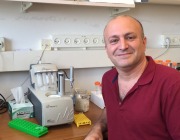Citation:
Abstract:
We have characterized the molecular basis of the interaction between ASPP2 and Bcl-2, which are key proteins in the apoptotic pathway. The C-terminal ankyrin repeats and SH3 domain of ASPP2 (ASPP2Ank-SH3) mediate its interactions with the antiapoptotic protein Bcl-2. We used biophysical and computational methods to identify the interaction sites of Bcl-2 and its homologues with ASPP2. Using peptide array screening, we found that ASPP2Ank-SH3 binds two homologous sites in all three Bcl proteins tested: (i) the conserved BH4 motif, and (ii) a binding site for proapoptotic regulators. Quantitative binding studies revealed that binding of ASPP2Ank-SH3 to the Bcl-2 family members is selective at two levels: (i) interaction with Bcl-2-derived peptides is the tightest compared to peptides from the other family members, and (ii) within Bcl-2, binding of ASPP2Ank-SH3 to the BH4 domain is tightest. Sequence alignment of the ASPP2-binding peptides combined with binding studies of mutated peptides revealed that two nonconserved positions where only Bcl-2 contains positively charged residues account for its tighter binding. The experimental binding results served as a basis for docking analysis, by which we modeled the complexes of ASPP2Ank-SH3 with the full-length Bcl proteins. Using peptide arrays and quantitative binding studies, we found that Bcl-2 binds three loops in ASPP2Ank-SH3 with similar affinity, in agreement with our predicted model. Based on our results, we propose a mechanism in which ASPP2 induces apoptosis by inhibiting functional sites of the antiapoptotic Bcl-2 proteins.

